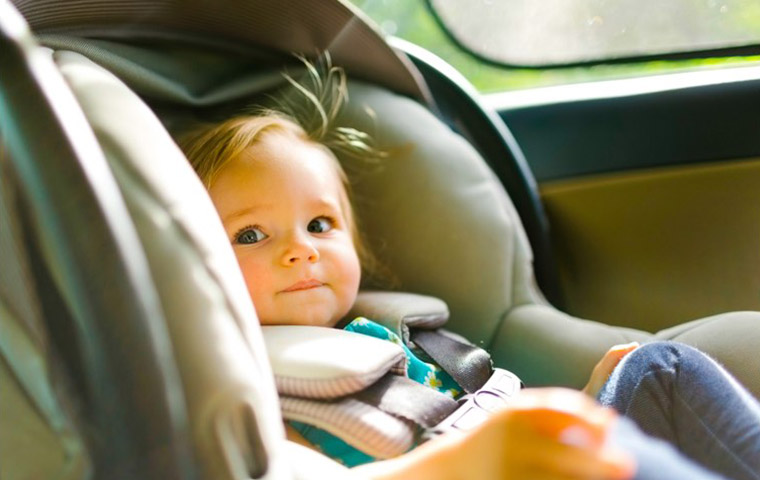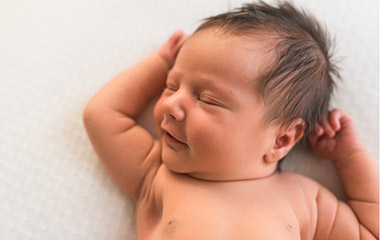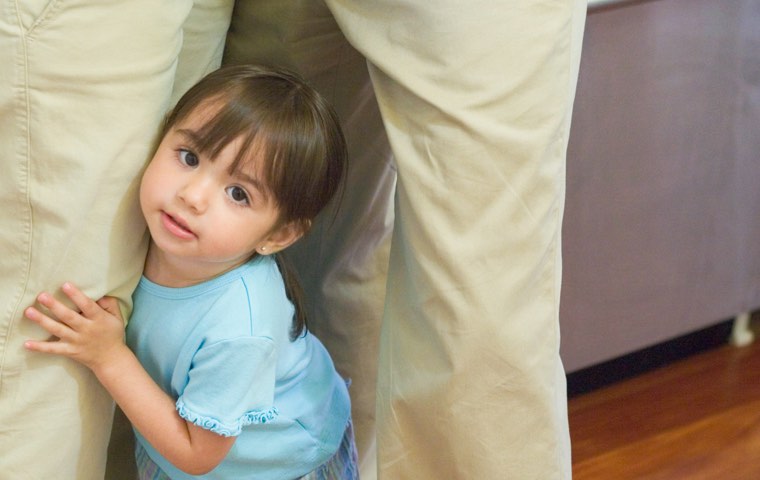Babyproofing Your Home
By GetParentingTips.com staff
Read Time: 7 Minutes
Babyproofing Basics
Babyproofing your home is one of those tasks that might seem easy... until you start. Suddenly your perfectly normal living room feels like the most dangerous place in the world, with sharp corners and electrical outlets everywhere. Babyproofing your house is a big job, and you're going to want to give yourself lots of time to make sure your home is as safe as possible for your little one. You don't have to start before your baby is born, but it's a good idea to make sure you have completed the items on your babyproofing checklist before your child starts crawling. And some little ones can start as early as 6 months. It can feel overwhelming, but don't panic - you'll do fine.
Need parenting help now?
The Texas Parent Helpline is available 24/7.
- Call 833-680-0611
- Chat with us
- Text 833-680-0611
Prevent Accidents Before They Happen
When babyproofing your home, your goal is to find and remove anything that could be dangerous or harmful. Go from room to room and get down low, or even sit on the floor, to try to see things from your baby's view. Try to imagine what a scooting, crawling, toddling child could pull down on top of him (or her), put into his mouth, bump his head on, catch his fingers in, or trip over. Anything that could be pulled down or put into a child's mouth should be removed. Anything that could tip over should be secured to walls with furniture straps or placed in a room that your baby doesn't go into.
We've shared some common dangers below in our babyproofing checklist, but every home is different. So, make sure your list fits your family's needs so your little one is safe when he starts exploring. There are a lot of steps in babyproofing your house, so let's get going!
Stairs.
If you have stairs in your home, use baby gates at both the top and bottom of the stairs. There are many types of baby gates available, but for stairways, gates that screw into the walls with mounted hardware are the safest choice. Make sure you measure the width of your stairway opening before buying a gate and look for one that will fit under or around the handrail. According to the American Academy of Pediatrics, stairs are one of the 10 most common sources of injury for toddlers and small children.
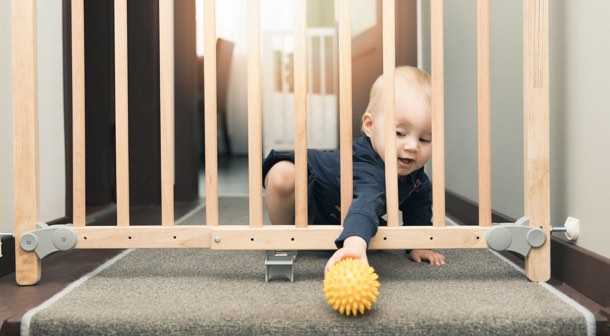
Windows.
Don't rely on screens to keep your child from falling out of windows. If possible, keep your windows locked and keep furniture away from them. Remove the cranks from casement windows. If you like to keep windows open, you can install screw-in window guards or use window stoppers to limit the distance a window can open. Also watch out for the cords on blinds and shades as they can be a strangulation hazard. You can use cord cleats to tie up hanging cords or cut any cord loops to shorten them and/or remove the continuous loop.
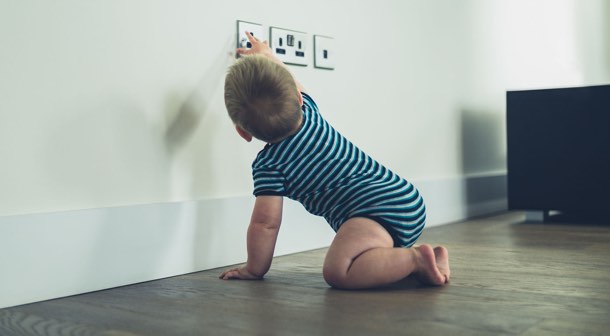
Electrical Outlets.
Make sure all electrical outlets are covered, even ones behind furniture. Check that all electrical cords are hidden, taped down, or otherwise out of reach.
Doors.
Some parents find using door or finger pinch guards helpful in protecting little fingers from being pinched or slammed in doors. Before your child starts walking, you'll want to get doorknob covers for doors that lead to areas that could be dangerous for them.
Furniture.
Watch out for furniture that babies could pull on or climb, including bookshelves, dressers, and cabinets. Furniture straps are a good way to anchor furniture and flat-screen TVs to walls. Most furniture straps have a metal cable or sturdy woven strap with brackets that screw into the wall on one side. On the other side of the furniture strap, screws or heavy-duty sticky pads attach the furniture strap to the item.
Pets.
Always watch babies around pets. Small children are known for pulling a pet's fur or hitting a pet. It's important to make sure pets are not startled when sleeping. It's also a good idea to keep animal food and water bowls behind a closed door and away from baby's reach since little ones will put most anything in their mouths.
Make sure your little one never takes a toy or bone from away from a dog. While your child may think he is playing the dog may not, and this could lead to a bad encounter
Other Hazards.
- Pick up anything small that children could swallow: batteries, small toys, coins, etc.
- Remove any bug or mouse traps.
- Keep bags and purses out of reach.
- If you have a firearm, make sure it's unloaded and locked up or secured with a trigger lock.
- Make sure all breakable decor is out of reach or put away.
Stove.
Put up a stove guard or knob covers to keep toddlers from accidentally turning the burners on. When cooking, use the stove's back burners and turn pot and pan handles back so children don't grab for them.
Doors and Drawers.
Secure the oven door, fridge, kitchen drawers, and cabinets with babyproof latches or locks.
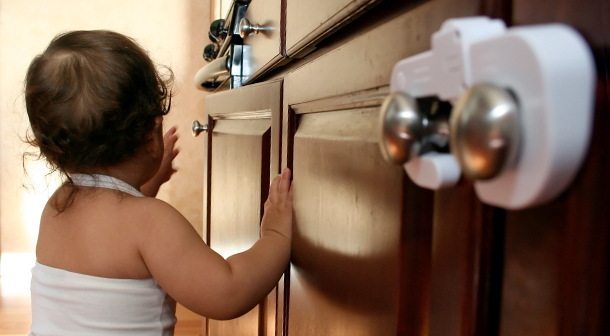
Appliances.
Move appliances (toasters, coffee makers, irons) away from counter edges and low shelves, and make sure their electrical cords are wrapped up, taped down, or otherwise secured.
Cleaning Supplies.
Move cleaning products, including dishwasher and laundry pods, out of reach. Be extra careful with brightly colored products that may look or smell like candy.
Trash.
Use a trash can with a childproof lid.
Dishes and Utensils.
Keep knives and cutlery out of reach. Use lightweight plastic dishes and utensils with rounded edges for babies.
Flooring.
Put a non-skid mat on the floor to avoid slipping accidents.
Doors and Drawers.
Put locks on the toilet lid and any low cabinets or drawers.
Bathtubs.
Never leave young children alone in the bathtub. Always drain the tub immediately after bath time. Make sure any appliances such as hair dryers, curling irons, and radios are far away from the tub, and that their electrical cords are put away and out of reach.
Personal Care Products.
Keep soap, shampoo, toothpaste, makeup, and razors out of reach.
Medicine.
Keep all pills and medicine out of reach and ask for childproof lids when you pick up prescriptions.
Plants.
Make sure your houseplants are baby-safe and keep them out of reach. Parlor palms, African violets, spider plants, and Swedish ivy are safer options for kids and pets.
Fireplaces.
Install a safety screen around the fireplace, and make sure any fireplace tools are out of reach.
Sharp Corners.
Use padded corner protectors on things with sharp edges such as coffee tables and shelves. Foam pieces that stick on with double-sided tape are a great option.

Fire Prevention
Make sure smoke and carbon monoxide detectors are installed and working, and test them once a month. Keep a fire extinguisher handy - many families like to keep it in the kitchen.
Cribs.
Make sure your crib meets safety standards, and keep a safe zone around the crib to prevent your child from grabbing window shades, art, mirrors, decorations, etc. Many cribs allow you to lower the mattress, a feature that could help prevent your child from climbing out of his crib or falling as he begins to stand. Be sure the crib is free of bumpers, pillows, blankets, and toys - while these are cute, they are a suffocation hazard. And always put baby to sleep on his back in a crib with tight-fitting sheets.
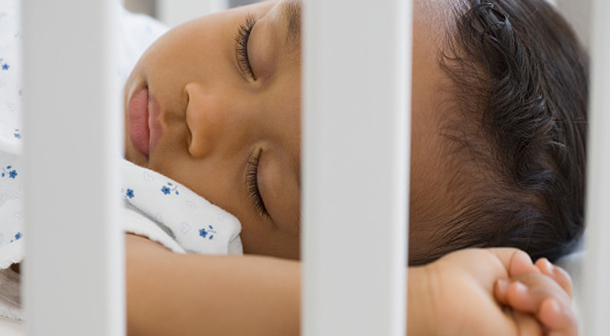
Changing Tables.
Don't leave children alone on a changing table.
Furniture.
To a curious toddler, a bookcase or dresser can look like the perfect place to practice climbing. Make sure any furniture or appliance that could tip over is secured with furniture straps.
Doors.
Install locks or doorknob covers on any door you don't want your child to open, such as a bathroom, storage closet, or garage.
Cars.
Store keys out of reach and don't let babies or children play in the car. When you get to your destination, check to make sure everyone is out of the car and lock it when you are not using it. Always make sure children are safely out of the way before backing your car out of the garage or driveway.
Pools and Water.
Never leave standing water in wading pools or buckets. If you have a pool, install a locking gate to keep out children and pets. If you can, add an alarm to a pool's gate door, so you can hear when someone opens it.
Pet Doors.
Keep pet doors locked or eliminate them. Babies and toddlers can slip out through pet doors, and this is especially dangerous if you have a pool or pond in your yard.
Cleaners and Chemicals.
Keep chemicals such as fertilizers, gasoline, cleaners, antifreeze, and bug spray in their original containers so you have all the safety warnings and information. Keep these kinds of products on high shelves out of reach of children.
Babyproofing: Take Things Room by Room
Babyproofing your home might seem overwhelming but it's easier if you take it one room at a time. You don't have to do everything at once. Download our Babyproofing Checklist to help you break down the tasks and make things more manageable.
Another good resource for parents is the Consumer Product Safety Commission. This government agency makes sure common household items are safe and issues recalls and warnings for products that have been found to be dangerous.


